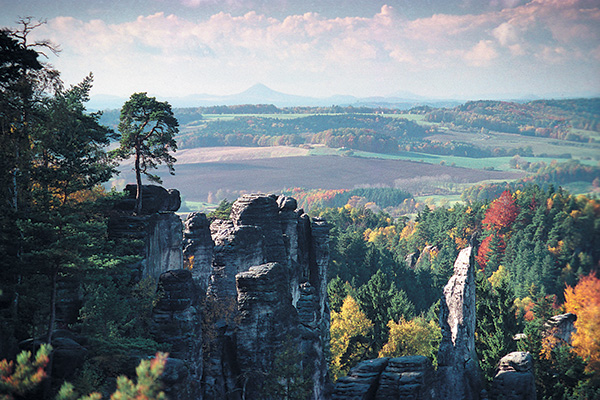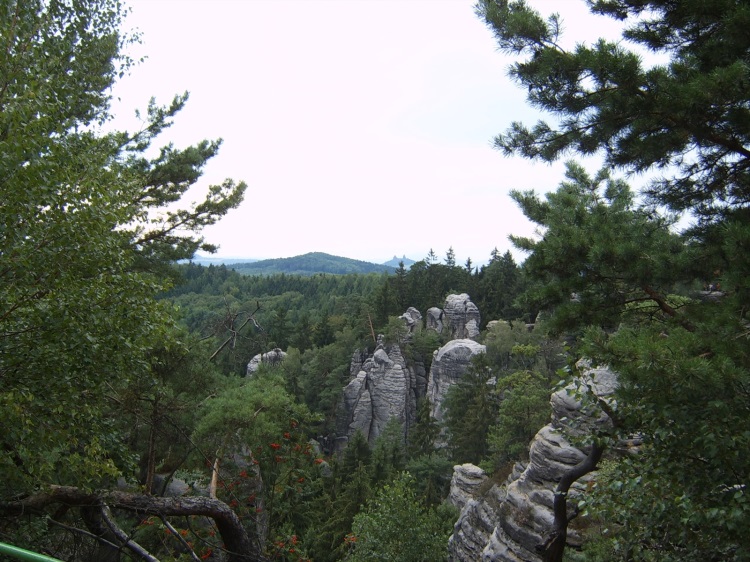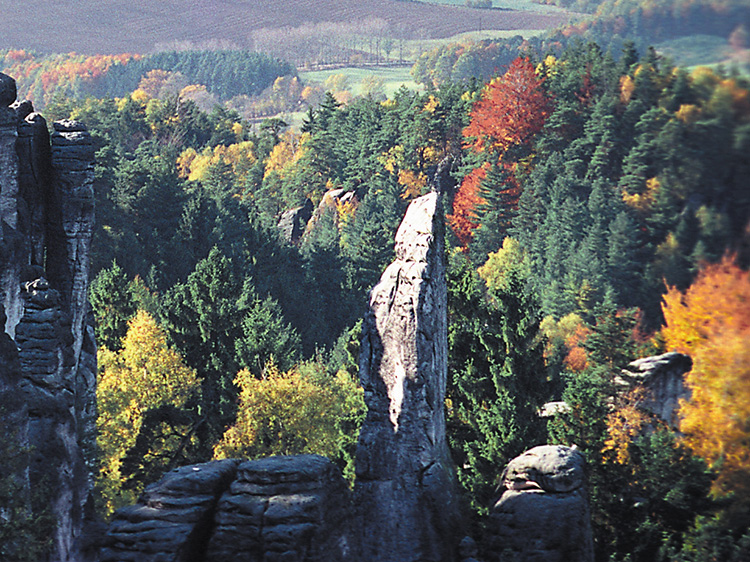
There are several biotopes in the Prachov Rocks, which are defined by the geological conditions of the rock town. Several of these biotopes have in the past been influenced by man, both positively (by building a systém of footpaths) or negatively (by planting spruce monocultures).

Dry biotopes, on the sunny sides of rocks, are inhabited by species that can do with very small amounts of moisture, such as some species of lichen, moss and heath. Birch trees and pine trees can be named for woody plants.
Remnants of old pine growths can be found on inaccessible rock blocks. In places where lumberjacks could not get in the past, some of these old pines can be several hundred years old. These places are carefully preserved these days.
Moist rock sides provide space for a bigger variety of plants such as Polypodium vulgare, Oxalis acetosella, club moss, bilberry and cranberry and some very rare lichens and moss. Several species of wood fern grow in several places.
Deciduous forests used to grow in much larger areas than nowadays, as evidenced by many local names like (Bukovina - Beechwood, U buku – At the Beech). Spring snowflake, Anemone hepatica, Wild ginger, Lily of the Valley and other plants growing in spring can be found in moist biotopes.
Solitary beech trees, often 200 to 300 years old, are left to grow in the Prachov rocks. When these trees are uprooted due to exposure to the elements, they become abodes for birds, insects and animals like shrew or yellow-necked mice.
Chaucer will happily do with just deer. Rich in population is the wild boar which live hidden within inaccessible terrain and only come out in late afternoon to scavenge for food. The fox and the badger are common here, while the hare is quite rare. Dogs can be very dangerous due to their snooping and chasing fawn and kit.

Coniferous forests, especially spruce forest which were purposely planted here, are a chapter on their own.

It is necessary to note here that the forests develop over hundreds of years. What we plant today will be judged by our successors in a hundred years, while nowadays we are now judging what was planted a hundred years ago. However, the function of the forest changes much faster than the forest really grows. The most important part of the modern day spruce forests is artificial planting in the 19th century. It was a common practice then to plant quick growing spruce monocultures due to a growing demand for construction wood, and this promised quality wood. After such growth reached its maturity it came to light that other natural forces affect it. The whole area of the Bohemian Paradise was struck by a calamity of nun moth caterpillars and whole areas of the forests had to be deforested. Old photographs of rock structures which are now overgrown by woods come from this era.

These parts were reforested around 1920, using a considerable amount of finances, with seedlings from the Alps region because there was a shortage of seedlings.

We are now facing the fact that tens of hectares of spruce monocultures are reaching the age of 80 to 100 years, or in other words, to the stage when the spruce is not vital anymore. Along with strong gales and snow windfall comes the age that the ambrosia beetle, the feared pest, likes the best. Ambrosia beetles can breed up to four times a season during hot summers and decimate wide areas of growth.

The classical defence relies on early discovery of areas attacked by Ambrosia beetles and cutting them down before the beetle matures into adolescence. Such wood has to be removed from the forest and processed immediately, thus discontinuing the Ambrosia beetle life cycle.
Another form is laying lures or catchers, which are deliberately felled trees that emanate a smell that lures the beetle, which then moves into the catchers. The next step is obvious. The catcher is moved out of the forest and processed at a sawmill. Another possibility is to poison the bug, but that should not be done in a reservation.

Pheromone catchers can also work very well. Beetles get lured by them, fall in and die.
Neither of those methods can catch all the beetles. There is always left enough of them to destroy a forest.
General prevention against insect and other calamities can be achieved by starting and planting trees in a way where there are all possible tree biotopes and the tree species are in a wide range of age, from seedlings to the oldest trees, and coming back to original deciduous species such as oak and beech trees in dry biotopes, mixed with pine trees.
We will see what our successors will think of us in a hundred years. Even now I think that they will reproach us for the shortage of spruce wood which will undoubtedly be an important industrial material.
J. M. Schlik, s.r.o.
Vokšice 1 - chateau
506 01 Jičín
IČO: 28830822
DIČ: CZ28830822
Tel.: +420 702 002 702
Tel.: +420 777 902 232
Email: info@prachovskeskaly.cz
#PrachovskeSkaly